 |
|
|
|

Manfrotto
393 (Bogen 3241) Gimbal Head
Jump to the section on...... [
Technique ] [
Equipment ]
|
First
of all I should note I have not used (at the time of this
writing) any brand or model of gimbal except the Manfrotto
393, so I cannot make any quantative comparisons with
other gimbal mounts except for the cost. The Manfrotto
393 can be purchased for 30%–80% less than
other comparable heavy-duty gimbals mounts. In other words,
those gimbals cost 3 to 5 times the price of the 393.
This cost difference is significant, amounting to several
hundred dollars. Any perceived difference in quality or
stability of the more expensive gimbals can hardly justify
that much extra expense. I do not believe they are that
much better in practical terms, if any better at all.
They may, however, offer advantages to some photographers
because of matching attachment brackets for flash or other
such accessories which could make them of particular interest.
The Manfrotto 393 gimbal doesn't offer such accessories.
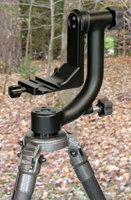 |
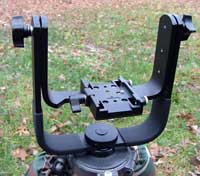 |
| Single
post gimbal |
The
393 two post gimbal |
The
major difference between the 393's design and other gimbals
is that it has two vertical posts and the others have
one vertical post. You might think two mounting points
would automatically make the 393 sturdier or more stable,
but in practice I don't think that necessarily provides
any real mechanical or stability advantage. The other
gimbals are apparently well made and do the job admirably.
In fact, I would say the single post gimbals have a bit
more elegant appearance - curvy and molded - while the
"U-shaped" 393's simple flat bar design looks rather industrial
and functional, with no particularly aesthetic attributes.
It seems though that this simple design is the another
difference (and advantage) which likely makes manufacture
of it much less costly, and those savings are passed on
to the photographer.
The
one other advantage of the 393 that greatly appeals to
me is its method of mounting the lens. All the other gimbals
use the popular "Arca-Swiss" style clamp, which works
with a variety of compatible mounting plates from various
manufacturers. The Manfrotto 393 comes with its own style
of mounting clamp and plate - the 357 Pro Quick Release
adapter. I frankly find it to be far superior to any brand
of "Arca-Swiss" compatible clamp/plate combo for heavy
lenses. This clamp and its matching plate - 357PL - is
the very same as I used 20 years ago to mount heavy three-tube
video cameras, which weighted even more than the super-telephoto
lens I use them with now.
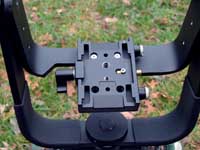 |
| 357
adapter (clamp) |
The
357 Pro Quick Release adaptor and plate are quite simply
foolproof. You cannot accidently loose a lens using these
because they have a safety catch (brass pin on right in
the left
photo). When you slide the plate into the clamp,
it snaps in and is locked from sliding out, even if you
fail to tighten the clamp against the plate. The "snap"
is loud and distinctive so you know it's been engaged.
This heavy-duty, failsafe plate and clamp is my mount
of choice.
For
awhile I owned an "Arca-Swiss" style clamp and plate on
an Acratech ballhead that I bought for lighter lenses.
When I first tried it out though, I was immediately struck
by the frighteningly minimal amount of clamping surface
contact between the clamp and the sliding plate. I was
not particularly comfortable with it and I continually
double-checked it every time I used it. Based on my experience
with it I would never trust it with any lens in the weight
class of the Canon 400mm f/2.8, 500mm or 600mm f/4's,
or larger.
Even
though the "Arca-Swiss" style plates I used with the Acratech
had stop screws to keep them from sliding out, it turns
out the stop screws also keep them from sliding in. Therefore,
the "Arca-Swiss" style clamp jaw had to be opened all
the way to insert the plate. The problem there was that
you may think the plate is safely clamped when it isn't.
If it falls out, it will take your camera and lens to
the ground with it. So much for safety stops. When using
the 357 clamp and plate I simply have no such concerns.
The clamp on the 357 does not hold the plate in, it only
locks the plate from sliding. The plate slides into the
non-moving part of the clamp, and will not slide out unless
the safety catch is released. Because the jaws do not
open, the plate cannot fall out. The Manfrotto 357 clamp
system is simply a safer to use mount, and comes standard
on the 393 gimbal.
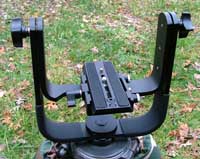 |
| 357
clamp with plate inserted |
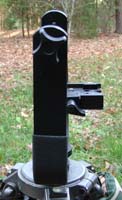 |
| Off-center
clamp |
An
important point to consider is balancing your lens/camera
combination in the gimbal. Manfrotto uses a smart design
of placing the 357 adapter clamp off center front to back.
The left
photo shows how it extends out to one side. By
reversing the direction that you mount your lens on the
357 clamp you can alter your balance point by an additional
two inches over the 357 plate's already generous 3-1/2
inches of slide range. Thus you get a whopping 5-1/2 inches
of total adjustment. This should easily accomodate even
the largest monster lens and camera combinations.
If
you use the "Arca-Swiss" type mounts, you will recognize
in the enlargement of the right
photo how much thicker the 357 plate and clamp
are compared to them. This gives a deep wedge to the clamp
making for a very secure connection. The two shiny knurled
screw heads on the right of the clamp are actually a 1/4
inch and a 3/16 inch stud. The clamp provides a place
to store a spare stud of each size. Since the mounting
foot on my 500mm lens has both a 1/4 inch and 3/16 inch
mounting hole, I actually use both studs to hold the lens
to the plate, providing extra security. The brass pin
in the top of the plate is spring-loaded. You can use
this instead of two studs to provide the anti-twist action
against the plate. Otherwise the spring-loaded pin just
pushes down below the plate out of the way.
You
might also note the internal (or upper) "U-bracket" has
three mounting holes for the tilt pivot point (the "see-saw"
hinge point). This is the one failing of the 393. These
are intened to allow the best-match of the tilt point
to the centerline of your lens, however, they completely
miss the mark. A 500mm or 600mm f/4 is too large to match
the centerline, even pivoting in the very end hole as
it comes from the manufacturer. The other holes would
only work smaller lenses. There is no adjustment the other
way for larger lenses. The result of this is the lens
tends to be a little "top heavy" and always tends to tilt
one way or the other, even when evenly balanced. Maintaining
even minimal tension with the tilt knobs will dampen this
tendency and avoid the slight annoyance otherwise.
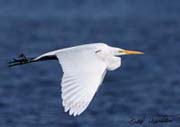 |
Panning
for flight shots
is silky smooth |
As
to the 393's useability, I have been quite satisfied with
it. It does just what it's supposed to do - balancing
my heavy 500mm lens so it tilts and pans smoothly and
effortlessly. I find the tilt tension easy to adjust with
the two knobs provided. In fact, having two knobs probably
makes fine adjustment easier than with a single knob,
and lets you lock the tilt with whichever hand is free.
Balancing the lens is easy with the generous sliding adjustment
range of the 357 plate and clamp. WIth the built-in safety
lock pin, I never have to worry about the plate accidently
slipping out of the clamp while adjusting the balance
point.
Panning
is smooth, and pan tension can be adjusted if necessary,
but the factory setting is usually on target. This is
not meant to be a frequent adjustment, as it requires
loosening a hex screw and twisting the base tension knob.
There is no "lock" function on the panning. The panning
knob has a form-fitted rubber grip that snaps over it,
but the cover is prone to working loose and getting lost.
I knew about this problem and kept a watch on mine, but
it got away from me despite my vigilance. It's not really
a problem since you should seldom need to adjust the base
tension, and the base knob is well knurled for a good
grip. However, I thought the rubber cover served double
duty as a rubber bumper in the event you tilt the lens
down too far, so I velcroed on a small cloth-covered foam
pad in place of the missing rubber knob cover. This has
actually proven not to be a necessity.
All
in all the Manfrotto 393 Gimbal head does the job well,
delivering a smooth, sturdy and reliable gimbal mounting
for even the largest of super-telephoto lens at a very
reasonable price. The simplicity of its design and build
means there are no complex mechanical parts to give trouble.
I don't see how you could have anything go wrong or give
trouble with this gimbal. The plus is its much safer and
more reliable clamp and slide plate as compared to the
"Arca-Swiss" compatible plates. Dollar for dollar I believe
it is a much better value than any of the other gimbal
heads. True to the Manfrotto line of equipment, you get
strong performance and good value with the 393 gimbal.
After
six years of looking, I have finally found a single post
gimbal, the Lens Master RH-2, that rivals the 393 in "bang
for your buck"......and, I can have my cake and eat it
too, because I was able to convert its Arca-Swiss quick
release to a Manfrotto 357 Pro QL, just like the 393.
Here's my review of the Lens
Master RH-2. |
| |
|
|
 |
|
 |
